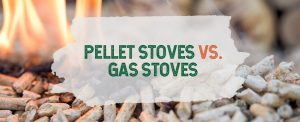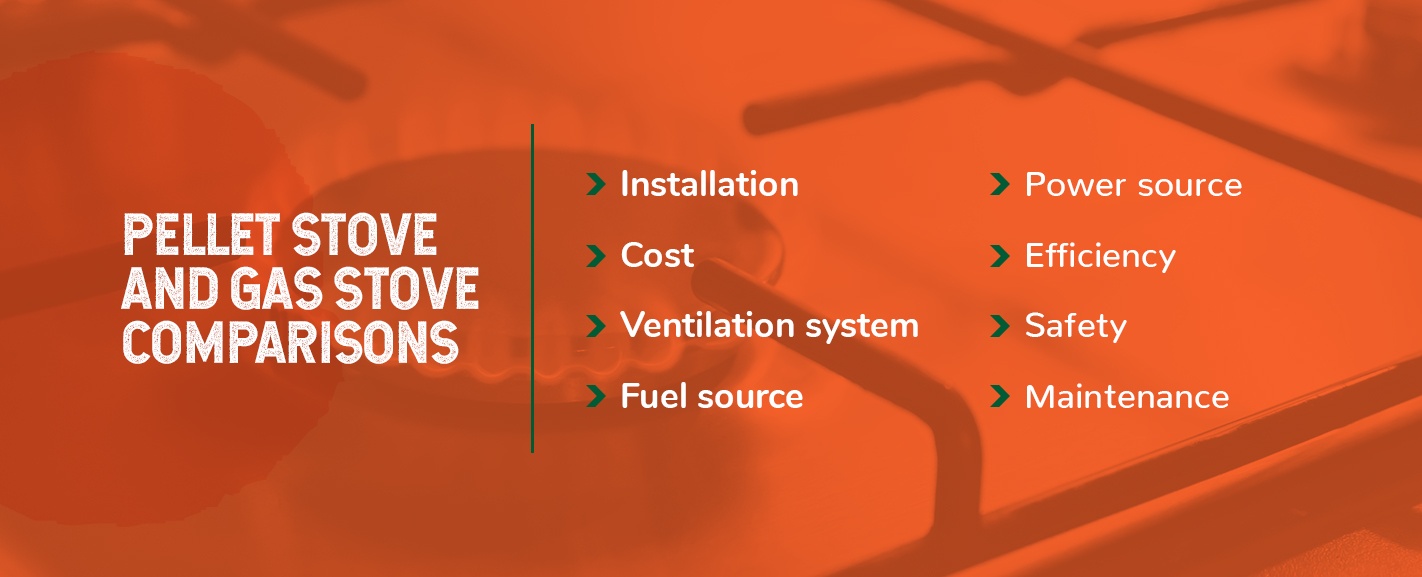Pellet Stoves vs. Gas Stoves

A pellet or gas stove can be an excellent addition to any home in colder climates. They both operate efficiently and provide heat to keep your household warm and comfortable all winter. These stoves make an ideal supplement or backup system for existing furnaces, and can continue working even if the power goes out. If you’re looking to add a stove to your home, and are not sure whether to install a gas stove or pellet stove, here’s everything you should know about these two types of stoves.
The Difference Between Pellet Stoves and Gas Stoves
While gas stoves and pellet stoves share many similarities in how they work to warm the house, plus their efficiency and safety, there are a few crucial differences between the two. The most notable disparity is in the types of fuel each stove uses — natural gas for a gas stove, and wood pellets for a pellet stove. There are also some minor differences in maintenance, cost and ventilation. There are pros and cons to each type, and the best one for you will depend on what works for your situation and your priorities.

Pellet Stove and Gas Stove Comparisons
There are several essential comparisons to keep in mind when choosing between pellet stoves and gas stoves. These are some of the most critical factors to consider.
- Installation: Both gas stoves and pellet stoves need direct ventilation to the outside, but may not need to use a traditional chimney. The ideal location will be central enough to heat the whole home, while also being close to an exterior wall for the proper ventilation system to the outdoors.
- Cost: The initial expenses, including purchase and installation, are very similar for pellet stoves and gas stoves. However, when you factor in the long-term costs, pellet stoves tend to be less expensive. Even with natural gas’ efficiency, the price of pellets is still lower, concerning what’s necessary to power a stove.
- Ventilation system: For both pellet stoves and gas stoves, the ventilation systems are relatively simple. Neither type of stove should need to use a chimney. A pellet stove usually vents through a small pipe and a hole in the wall near the unit. A gas stove uses a direct vent system for ventilation.
- Fuel source: Just as the names imply, gas stoves use natural gas as the fuel source, and pellet stoves use a special kind of wood pellet for fuel. Natural gas is a fossil fuel. Usually, pipelines connected to the home deliver the gas automatically. If you live in a rural area without access to municipal services, you can opt to have the gas delivered and stored in a tank near your home. The pellets for pellet stoves usually consist of lumber industry byproducts — compressed sawdust, wood chips, twigs and other wood products — and may sometimes include other materials such as corncobs or fruit pits. Pellets come in large 40-pound bags and are available anywhere you can purchase pellet stoves and most home improvement stores.
- Power source: Besides the main fuel sources, both gas stoves and pellet stoves will often use an electrical connection. The electric power runs the fan on both kinds of stoves to distribute the heat, though the stoves will still generate some heat even without the electric fan.
- Efficiency: Pellet stoves and gas stoves have very similar efficiency. The BTU ratings will vary depending on the brand and model you choose, but gas and pellet stoves have similar BTU ratings and efficiency levels.
- Safety: Both types of stoves are safe to use. However, remember they get very hot when in use, so to avoid burns, try not to touch the glass on either stove. As with any appliance that burns natural gas, there is always a slight risk of a carbon monoxide leak. However, with proper venting and a carbon monoxide detector, it shouldn’t be an issue.
- Maintenance: You can turn a gas stove on and off whenever you want to use it, but it does require some periodic maintenance, checks including pipeline inspections and vent cleanings. Pellet stoves require a somewhat more involved daily maintenance routines. You need to fill it up with fresh pellets at least daily, possibly more often, and you will regularly need to clean out the ashes that build up with use. Occasional upkeep, including cleaning out air holes and other components, is also a smart habit to adopt.
Wood Pellet Stove Efficiency
Are wood pellet stoves the best? Gas stove and pellet stove heating benefits are notable for homes in cold climates, and the better choice for you can depend on your budget and the maintenance level you’re comfortable with, among other factors. While priced similarly, pellet stoves are often slightly less expensive to purchase, install and operate. Pellet stoves are better than gas stoves for anyone who lives in a more rural area, away from city gas line hookups.
Wood pellets burn very efficiently — indeed, they are one of the most efficient fuel burners available. You can source compressed wood pellets locally, and they’re easy to find and purchase. The pellets use byproducts the lumber and agricultural industries would otherwise waste, and the plant materials are a renewable resource.
Wood Pellets From Energex
If you are thinking about buying a pellet stove, choose the best wood pellets from Energex. Our highest-quality wood pellets meet the EPA’s New Source Performance Standards required to maintain your stove’s warranty. We are also proud to have earned certification from the Pellets Fuel Institute Standards Program, meaning our wood pellets meet even stricter performance and quality specifications. Our credentials make our pellet quality unmatched by any other wood pellet company.
You can find our bagged pellets at several Pennsylvania-area retailers, or make things even more convenient with bulk deliveries of our premium wood pellets. Have bulk pellets delivered directly to your Pennsylvania home or business, saving you the hassle of buying and hauling bags of pellets. Contact Energex today to see if delivery is available in your area, or if you have any questions about pellet fuel. Our expert customer service reps are happy to help.


